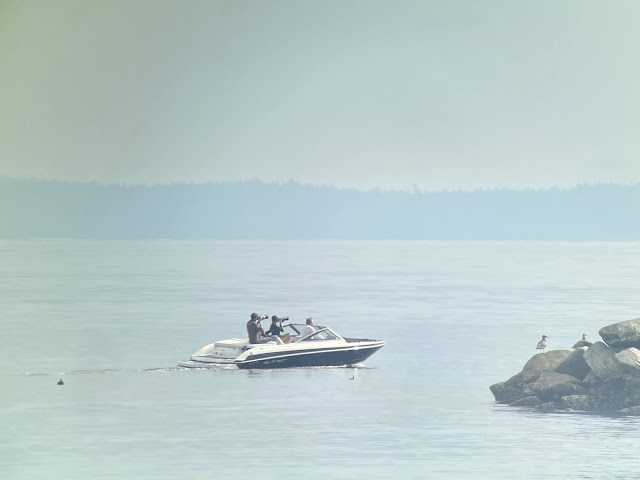My first LONG-TAILED JAEGER in Metro Vancouver and why we need to study juv jaegers closely!
You may remember my post about getting the Short-tailed Shearwater a few days ago. If not you can check it out HERE. Well during that trip we photographed a juvenile Jaeger. At the time it flew around our boat very fast near the breakwater at the Tsawwassen Ferry Terminal. It was also viewed from land by Rob Lyske and Yousif Attia as they stood on shore also searching for the Short-tailed Shearwater. At the time all 5 of us (on the water and on land) called it a Parasitic Jaeger (PAJA). We did so because it flew very fast not allowing for critical study and also because we defaulted to the common juvenile Jaeger seen in our waters. Also because we were fervently searching for the reported Short-tailed Shearwater we were not paying as close enough attention as we should have.
Anyways after critical photo study last night while reviewing photos on our cards we realized this was indeed a juvenile Long-tailed Jaeger (LTJA). Because this bird is very rare for Metro Vancouver and because juv Jaeger species are so notoriously difficult to id I also sent the photos to experts in WA and California. Everyone came back with the confirmation that this was indeed a juvenile Long-tailed Jaeger. This was a new Metro Vancouver bird for everyone on board and on land except for Ilya who saw one adult from the Tsawwassen to Nanaimo ferry in 2007.
So here are the reasons as to why we figured out this bird was a Long-tailed Jaeger (all the below features can be viewed in the photos below from all of us):
1. Only 2 white primary shafts on the wing (PAJA have 4, LTJA 1-3 max)
2. The white primary flash on the underside is very small and appears notched near p9 which is a LTJA feature
3. There are no apparent buff tips on the upperside of the primaries as in PAJA
4. The undertail and uppertail coverts look boldy and neatly barred (not wavy and irregular like in PAJA)
5. The overall colour tone appears rather cold greyish instead of warm rusty as in PAJA.
6. The trailing edge of the secondaries are sharply contrastingly much blacker than the rest of the upperwing.
7. The blunt tips to the longish central rectrices are diagnostic for juv LTJA.
8. Note also the bill with the nail about half the length, on PAJA the nail is about one-third.
Here are some photos of the bird I took:
Some photos Ilya Povalyaev took:
Some photos Bridget Spencer took (including a closeup when it flew over the boat):
Rob Lyske’s photo from land (note how close those fisherman got to the bird!)
A video taken by Yousif Attia through his scope of the bird below:
A photo of us on the boat shooting the LTJA photographed by Yousif Attia on land.
This lesson teaches me that I must ALWAYS carefully and critically study juv Jaegers in the Vancouver area and not simply default to Parasitic. Plus it goes without saying that if the jaeger is too far away it is best to eBird it as jaeger sp.
This was a crazy day in Vancouver the day we photographed the Long-tailed Jaeger because on the same day there was a Short-tailed Shearwater and Christopher Di Corrado found an adult Pomarine Jaeger off Steveston. Also we had the thrill of watching an adult dark and light morph Parasitic Jaeger fight over a dragonfly.
Anyways this has made our little boat trip even the more special! 2 new Metro Vancouver birds for us and a great learning experience. Birding is one of the greatest hobbies because it always keeps you on your toes and you are always continuously learning!






















very cool mel! I learned something too. I don't think I ever would have figured out this ID! well done what a great trip you had out on the water!
ReplyDeletethank you aaron!
Delete